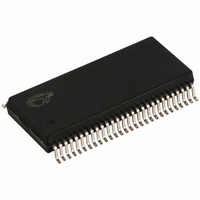CY7C66113-PVC Cypress Semiconductor Corp, CY7C66113-PVC Datasheet - Page 34

CY7C66113-PVC
Manufacturer Part Number
CY7C66113-PVC
Description
IC MCU 8K USB HUB 4 PORT 56TSSOP
Manufacturer
Cypress Semiconductor Corp
Specifications of CY7C66113-PVC
Applications
USB Hub/Microcontroller
Core Processor
M8
Program Memory Type
OTP (8 kB)
Controller Series
USB Hub
Ram Size
256 x 8
Interface
I²C, USB, HAPI
Number Of I /o
31
Voltage - Supply
4 V ~ 5.5 V
Operating Temperature
0°C ~ 70°C
Mounting Type
Surface Mount
Package / Case
56-SSOP
Operating Temperature (max)
70C
Operating Temperature (min)
0C
Operating Temperature Classification
Commercial
Mounting
Surface Mount
Pin Count
56
Lead Free Status / RoHS Status
Contains lead / RoHS non-compliant
For Use With
CY3649 - PROGRAMMER HI-LO USB M8428-1339 - KIT LOW SPEED PERSONALITY BOARD
Lead Free Status / RoHS Status
Not Compliant, Contains lead / RoHS non-compliant
Other names
428-1330
Available stocks
Company
Part Number
Manufacturer
Quantity
Price
Company:
Part Number:
CY7C66113-PVC
Manufacturer:
CY
Quantity:
10
In this description, “Firmware” refers to embedded firmware in the CY7C66x13 controller.
10.Once the device receives a Set Configuration request, its functions may now be used.
11.Following enumeration as a hub, Firmware can optionally indicate to the host that a compound device exists (for example, the
12.The host carries out the enumeration process with this additional function as though it were attached downstream from the hub.
13.When the host assigns an address to this device, it is stored as the other USB address (for example, Address A).
18.0
A USB hub is required to support:
These features are mapped onto a hub repeater and a hub controller. The hub controller is supported by the processor integrated
into the CY7C66013 and CY7C66113 microcontrollers. The hardware in the hub repeater detects whether a USB device is
connected to a downstream port and the interface speed of the downstream device. The connection to a downstream port is
through a differential signal pair (D+ and D–). Each downstream port provided by the hub requires external R
each signal line to ground, so that when a downstream port has no device connected, the hub reads a LOW (zero) on both D+
and D–. This condition is used to identify the “no connect” state.
The hub must have a resistor R
The hub generates an EOP at EOF1, in accordance with the USB 1.1 Specification, Section 11.2.2.
18.1
A low-speed (1.5 Mbps) USB device has a pull-up resistor on the D– pin. At connect time, the bias resistors set the signal levels
on the D+ and D– lines. When a low-speed device is connected to a hub port, the hub sees a LOW on D+ and a HIGH on D–.
This causes the hub repeater to set a connect bit in the Hub Ports Connect Status register for the downstream port. Then the hub
repeater generates a Hub Interrupt to notify the microcontroller that there has been a change in the Hub downstream status.
A full-speed (12 Mbps) USB device has a pull-up resistor from the D+ pin, so the hub sees a HIGH on D+ and a LOW on D–. In
this case, the hub repeater sets a connect bit in the Hub Ports Connect Status register, clears a bit in the Hub Ports Speed register
(for full-speed), and generates a Hub Interrupt to notify the microcontroller of the change in Hub status. The firmware sets the
speed of this port in the Hub Ports Speed Register (see Figure 18-2)
Connects are recorded by the time a non-SE0 state lasts for more than 2.5 s on a downstream port.
When a USB device is disconnected from the Hub, the downstream signal pair eventually floats to a single-ended zero state. The
hub repeater recognizes a disconnect once the SE0 state on a downstream port lasts from 2.0 to 2.5 s. On a disconnect, the
corresponding bit in the Hub Ports Connect Status register is cleared, and the Hub Interrupt is generated.
Document #: 38-08024 Rev. *A
Hub Ports Connect Status
1. The host computer sends a SETUP packet followed by a DATA packet to USB address 0 requesting the Device descriptor.
2. Firmware decodes the request and retrieves its Device descriptor from the program memory tables.
3. The host computer performs a control read sequence and Firmware responds by sending the Device descriptor over the USB
4. After receiving the descriptor, the host sends a SETUP packet followed by a DATA packet to address 0 assigning a new USB
5. Firmware stores the new address in its USB Device Address Register (for example, as Address B) after the no-data control
6. The host sends a request for the Device descriptor using the new USB address.
7. Firmware decodes the request and retrieves the Device descriptor from program memory tables.
8. The host performs a control read sequence and Firmware responds by sending its Device descriptor over the USB bus.
9. The host generates control reads from the device to request the Configuration and Report descriptors.
Bit #
Bit Name
Read/Write
Reset
• Connectivity behavior: service connect/disconnect detection
• Bus fault detection and recovery
• Full-/low-speed device support.
bus, via the on-chip FIFOs.
address to the device.
sequence completes.
keyboard in a keyboard/hub device).
Connecting/Disconnecting a USB Device
USB Hub
7
Reserved
R/W
0
6
Port 7 Connect
Status
R/W
0
UUP
connected between its upstream D+ line and V
5
Port 6 Connect
Status
R/W
0
Figure 18-1. Hub Ports Connect Status
4
Port 5 Connect
Status
R/W
0
3
Port 4 Connect
Status
R/W
0
REG
2
Port 3 Connect
Status
R/W
0
to indicate it is a full speed USB device.
1
Port 2 Connect
Status
R/W
0
CY7C66013
CY7C66113
UDN
ADDRESS 0x48
Page 34 of 58
resistors from
0
Port 1 Connect
Status
R/W
0











